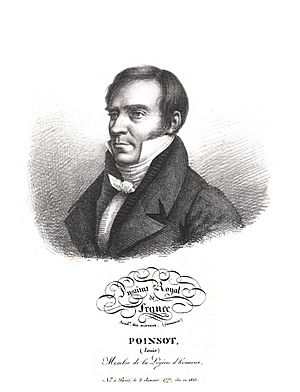Louis Poinsot facts for kids
Quick facts for kids
Louis Poinsot
|
|
|---|---|
 |
|
| Born | 3 January 1777 |
| Died | 5 December 1859 |
| Nationality | French |
| Alma mater | École Polytechnique École des Ponts et Chaussées |
| Scientific career | |
| Institutions | Lycée Bonaparte Imperial University of France |
Louis Poinsot (born January 3, 1777 – died December 5, 1859) was a smart French mathematician and physicist. He invented a way to understand how forces work on solid objects, called geometrical mechanics. He showed how many forces pushing on something could be simplified into just one main push and a twisting motion.
Life of Louis Poinsot
Louis Poinsot was born in Paris, France, on January 3, 1777. When he was young, he went to a school called Lycée Louis-le-Grand. This school helped him get ready for the famous École Polytechnique.
In 1794, when Louis was 17, he tried to get into École Polytechnique. He didn't do well on the algebra part of the test, but he still got accepted! He studied there for two years.
After that, in 1797, he went to École des Ponts et Chaussées. He planned to become a civil engineer, which meant building things like bridges and roads. But while he was there, he found his true love: abstract mathematics. He loved solving math problems that were just about ideas, not practical building.
Because of his new passion, Poinsot left civil engineering. From 1804 to 1809, he became a math teacher at a high school in Paris called Lycée Bonaparte. Later, he became an inspector for the Imperial University of France. He shared this job with another famous mathematician, Delambre.
On November 1, 1809, Poinsot went back to his old school, École Polytechnique. This time, he was an assistant professor of math and mechanics. Even while changing jobs, Poinsot kept doing his own math research. He published many papers on geometry and how things move. By 1809, he was very well known for his work.
By 1812, Poinsot wasn't teaching directly at École Polytechnique anymore. He had other mathematicians teach for him, like Cauchy. He lost his teaching job in 1816 when the school changed things around. But he still worked there for 10 more years, helping to decide who got into the school.
From 1839 until he died, Poinsot also worked at the famous Bureau des Longitudes. This place focused on astronomy and time. When the great mathematician Joseph-Louis Lagrange died in 1813, Poinsot was chosen to take his place at the Académie des Sciences. This was a very high honor.
In 1840, he joined a special council for public education. In 1846, he received an award called the Officer of the Legion of Honor. In 1852, he became a member of the Senate, which is a part of the French government. In 1858, he was chosen as a Fellow of the Royal Society of London, a top science group in England.
Louis Poinsot passed away in Paris on December 5, 1859. He is buried in the Pere Lachaise Cemetery in Paris.
Legacy and Tributes
Louis Poinsot is remembered in several ways:
- A crater on the Moon is named after him.
- There is a street in Paris called Rue Poinsot.
- Gustave Eiffel included Poinsot's name among the 72 names of important French scientists on the Eiffel Tower.
Poinsot's Work
Poinsot was the person who came up with "geometrical mechanics." This is a way to understand how forces act on a solid object. He showed that many forces pushing on something can be simplified into just one main push and a twisting motion. Before Poinsot, people studied how solid objects moved using only complex math formulas. Poinsot's work made it possible to actually see and imagine how these objects move, just like you can imagine a single point moving. This idea is now known as Poinsot's construction. It helps describe how a spinning object moves when one point on it stays still.
In 1809, he discovered four special shapes called Kepler-Poinsot polyhedra. Two of these shapes had actually been found by Johannes Kepler much earlier, but Poinsot didn't know that. The other two are sometimes called the Poinsot solids.
Poinsot also studied number theory, which deals with numbers and equations. But he is most famous for his work in geometry. Along with another mathematician named Monge, Poinsot helped make geometry a very important part of math research in France in the 1800s. To make geometry even more important, Poinsot helped create a special teaching position for advanced geometry at the Sorbonne in 1846. He created this position for his friend Michel Chasles, who held it until he died.
Images for kids
See also
 In Spanish: Louis Poinsot para niños
In Spanish: Louis Poinsot para niños





